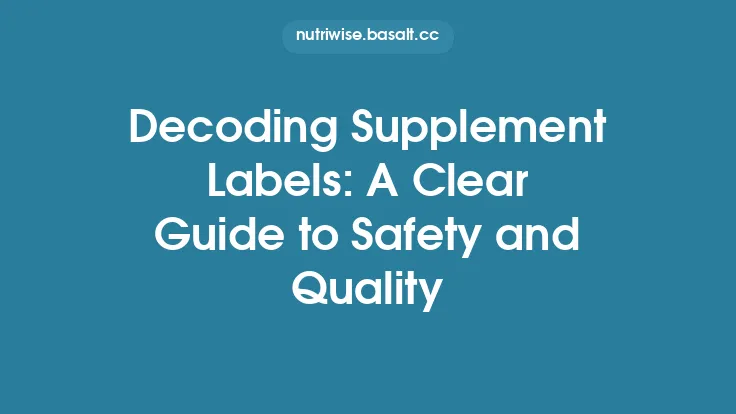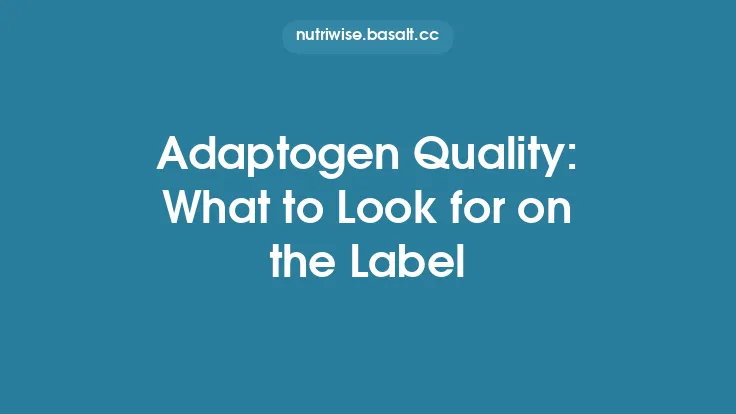Protein supplements are marketed with eye‑catching claims, glossy packaging, and a barrage of numbers. While the promise of “muscle‑building power” or “fast recovery” can be compelling, the real story lies in the label. A well‑crafted label not only complies with regulations but also equips you with the data needed to decide whether a product aligns with your nutritional goals, budget, and health considerations. Below is a comprehensive guide to the essential elements you should scrutinize when evaluating protein supplement labels.
Understanding the Nutrition Facts Panel
The Nutrition Facts panel is the cornerstone of any supplement label. It provides a standardized snapshot of the product’s macronutrient and micronutrient composition per serving. When reviewing this panel, pay attention to:
| Element | What to Look For | Why It Matters |
|---|---|---|
| Serving Size | Usually listed in grams (g) or scoops. Verify that the serving size matches the amount you intend to consume. | Misaligned serving sizes can lead to under‑ or over‑consumption of protein and calories. |
| Calories | Total calories per serving, broken down into calories from protein, fat, and carbohydrates. | Helps you fit the supplement into your overall energy budget. |
| Protein (g) | Amount of protein per serving, expressed in grams. | Direct indicator of the product’s primary purpose. |
| Total Fat (g) | Includes saturated, trans, and sometimes poly‑ and monounsaturated fats. | Excessive fat can affect calorie density and digestion. |
| Total Carbohydrate (g) | Includes dietary fiber and sugars. | Important for those monitoring carb intake or seeking low‑carb options. |
| Sodium (mg) | Sodium content per serving. | High sodium may be a concern for individuals on low‑sodium diets. |
| Vitamins & Minerals | Often listed as % Daily Value (DV). | May provide added nutritional benefits, but excessive amounts can be unnecessary. |
Tip: Compare the Nutrition Facts across brands using the same serving size. If one product lists 30 g of protein per 30 g scoop while another lists 25 g per 35 g scoop, the former delivers a higher protein density.
Decoding the Protein Content
Beyond the headline “X g of protein per serving,” the label can reveal nuances that affect quality and efficacy:
- Protein Quantity vs. Net Protein: Some manufacturers subtract non‑protein nitrogen (e.g., from added amino acids) to present a “net protein” figure. Verify whether the listed protein amount reflects the actual protein mass or an adjusted value.
- Protein Source Disclosure: While the article’s scope excludes deep dives into protein types, the label should still specify the source (e.g., whey concentrate, soy isolate). This transparency allows you to cross‑reference with any personal dietary restrictions.
- Protein Digestibility: Look for statements about “rapidly digestible” or “slow‑release” proteins. Although not a guarantee of quality, such claims often indicate the presence of specific processing methods (e.g., hydrolysis) that affect absorption rates.
- Protein per Calorie Ratio: A high protein-to-calorie ratio (e.g., >0.5 g protein per kcal) suggests a leaner product, which is useful for those aiming to increase protein without adding excess calories.
Ingredient List: What to Spot
The ingredient list, ordered by weight, offers insight into the product’s composition beyond the macro breakdown:
- Primary Protein Ingredient(s): Should appear as the first or second ingredient. If fillers or sweeteners dominate the top of the list, the protein concentration may be lower than expected.
- Added Amino Acids: Look for branched‑chain amino acids (BCAAs), glutamine, or taurine. While these can enhance the supplement’s functional profile, they also add cost. Ensure the amounts are disclosed; vague “added amino acids” without quantities can be a red flag.
- Sweeteners: Common options include sucralose, stevia, monk fruit, or sugar alcohols (e.g., erythritol). If you have sensitivities, note the type and quantity (often listed in the “Other Ingredients” section).
- Thickening & Texture Agents: Ingredients like xanthan gum, guar gum, or carrageenan improve mouthfeel. While generally safe, some individuals prefer to avoid certain gums due to digestive concerns.
- Flavorings & Colorings: Natural flavors and colors (e.g., beet juice) are preferable for those avoiding artificial additives. However, “artificial flavor” or “artificial color” may indicate a more processed product.
- Preservatives: Look for citric acid, potassium sorbate, or other preservatives. Their presence is not inherently problematic but may be relevant for those seeking minimally processed supplements.
Amino Acid Profile and Its Relevance
A detailed amino acid breakdown is often found on the back of the label or in a supplemental table. Key points to evaluate:
- Essential Amino Acids (EAAs): The nine EAAs (histidine, isoleucine, leucine, lysine, methionine, phenylalanine, threonine, tryptophan, valine) must be present in sufficient quantities for muscle protein synthesis. A complete profile indicates a high‑quality protein source.
- Leucine Content: Leucine is a primary trigger for the mTOR pathway, which initiates muscle protein synthesis. Many experts recommend at least 2–3 g of leucine per serving for optimal anabolic response.
- Branched‑Chain Amino Acids (BCAAs): While BCAAs are part of the EAA set, some labels highlight them separately. Verify that the BCAA total aligns with the overall EAA content; inflated BCAA claims without proportional EAAs can be misleading.
- Non‑Essential Amino Acids (NEAAs): Though not required in the diet, NEAAs like glutamine and arginine can support recovery and immune function. Their inclusion is a bonus but not a necessity.
Practical Check: Add up the grams of all listed amino acids. The sum should be close to the total protein grams per serving. A significant discrepancy may indicate the presence of non‑protein nitrogen or incomplete reporting.
Calorie and Macronutrient Breakdown
Understanding how protein fits into the broader macronutrient landscape of the supplement helps you manage total daily intake:
- Caloric Density: Calculate calories per gram of product (total calories ÷ total weight of the serving). Low caloric density (≈3–4 kcal/g) is typical for pure protein powders, whereas higher values suggest added fats or carbs.
- Fat and Carbohydrate Sources: Identify whether fats come from added oils (e.g., MCT, coconut) or are inherent to the protein source. Carbohydrates may stem from maltodextrin, dextrose, or fiber. Knowing the source informs decisions about glycemic impact and digestive tolerance.
- Fiber Content: Some protein powders incorporate soluble fiber (e.g., inulin) to improve texture and satiety. While beneficial for gut health, excessive fiber can cause bloating for sensitive individuals.
- Sugar Content: Pay attention to “Total Sugars” and “Added Sugars.” Low or zero added sugars are preferable for most performance‑oriented users.
Allergen Information and Sensitivities
Allergen labeling is mandatory in many jurisdictions, but the level of detail can vary:
- Declared Allergens: Look for bolded or highlighted statements such as “Contains milk, soy, egg.” This is crucial for individuals with diagnosed allergies.
- Cross‑Contamination Statements: Phrases like “May contain traces of nuts” indicate shared manufacturing lines. If you have severe allergies, opt for products certified allergen‑free.
- Gluten‑Free Certification: Even if the ingredient list lacks wheat, barley, or rye, a gluten‑free seal provides added assurance for those with celiac disease or gluten sensitivity.
- Lactose Content: Some whey isolates are virtually lactose‑free, but the label may still list “lactose” under “Other Ingredients” if present in trace amounts.
Claims, Certifications, and Third‑Party Testing
Marketing claims can be persuasive, but verification is essential:
- “Certified Organic” or “Non‑GMO” Labels: These indicate compliance with specific agricultural standards. Verify the certifying body (e.g., USDA Organic, NSF Non‑GMO Project).
- “Informed‑Sport Certified” or “NSF Certified for Sport”: Third‑party testing for banned substances is vital for competitive athletes. The presence of such logos assures that the product has been screened for contaminants.
- “No Artificial Sweeteners” or “Zero Sugar”: These claims should be corroborated by the ingredient list. If a sweetener is present, the claim may be misleading.
- “Made in a GMP‑Certified Facility”: Good Manufacturing Practices (GMP) certification signals adherence to quality control standards.
- Expiration Date and Batch/Lot Number: A clear expiration date ensures product potency. The batch/lot number allows traceability in case of recalls.
Serving Size, Servings Per Container, and Cost Analysis
Beyond nutritional content, practical considerations affect long‑term use:
- Servings Per Container: Divide the total product weight by the serving size to confirm the number of servings. Discrepancies can indicate mislabeling.
- Cost per Gram of Protein: Calculate the price per gram of protein (product price ÷ (protein per serving × number of servings)). This metric enables objective cost comparisons across brands.
- Bulk vs. Single‑Serve Options: Larger containers often reduce cost per gram but may have a shorter shelf life after opening. Consider your consumption rate.
- Convenience Features: Some products include a “ready‑to‑drink” (RTD) format, which may carry a premium price. Evaluate whether the added convenience justifies the cost.
Shelf Life, Storage Instructions, and Packaging
Protein supplements can degrade over time, especially if exposed to heat, moisture, or light:
- Shelf Life: Typically 12–24 months from the manufacturing date. Look for a “Best By” or “Use By” date rather than a vague “Consume within X months after opening.”
- Storage Recommendations: Most powders advise a cool, dry place. Some may recommend refrigeration after opening, especially if the product contains added probiotics or enzymes.
- Packaging Material: Resealable pouches, foil‑lined containers, or opaque jars protect against moisture and oxidation. Transparent containers may expose the product to light, potentially degrading sensitive amino acids.
- Tamper‑Evident Seals: Ensure the seal is intact upon purchase. Broken seals could indicate product compromise.
Regulatory Compliance and Country‑Specific Labeling
Regulations differ between regions (e.g., FDA in the United States, EFSA in the European Union, Health Canada). Understanding these differences helps you gauge label reliability:
- Nutrition Facts Format: The U.S. requires a specific layout, while the EU uses a “Nutrition Information” table with slightly different units (e.g., kJ vs. kcal).
- Health Claims: In the U.S., the FDA restricts health claims on supplements unless substantiated. In the EU, the European Food Safety Authority (EFSA) evaluates claims. Look for “Authorized Health Claim” statements.
- Ingredient Naming Conventions: Some regions mandate the use of INCI (International Nomenclature of Cosmetic Ingredients) names for certain additives. Consistency across markets can indicate a globally standardized product.
- Import/Export Labels: If purchasing an international brand, verify that the label complies with your local regulations. Non‑compliant labels may lack required allergen warnings or nutritional disclosures.
Putting It All Together: A Practical Checklist
Use the following step‑by‑step checklist when you pick up a protein supplement:
- Verify Serving Size & Protein Density – Ensure the protein grams per gram of product meet your needs.
- Read the Nutrition Facts Panel – Confirm calories, macronutrients, and micronutrients align with your diet.
- Scrutinize the Ingredient List – Look for the primary protein source at the top, minimal fillers, and transparent sweetener types.
- Check the Amino Acid Profile – Confirm a complete EAA set and adequate leucine (≥2 g per serving).
- Assess Allergen Statements – Identify any declared allergens or cross‑contamination warnings.
- Evaluate Claims & Certifications – Look for third‑party testing logos, organic/non‑GMO seals, and GMP compliance.
- Calculate Cost per Gram of Protein – Compare price efficiency across brands.
- Inspect Shelf Life & Storage Guidance – Ensure the product is fresh and stored properly.
- Confirm Regulatory Compliance – Verify that the label meets your country’s labeling standards.
- Record Batch/Lot Number & Expiration Date – Keep this information for future reference or in case of a recall.
By systematically applying this framework, you can cut through marketing hype and select protein supplements that are transparent, nutritionally appropriate, and aligned with your performance goals. The label is more than a legal requirement—it’s a roadmap to informed supplementation.





